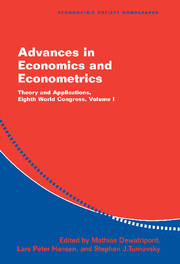Book contents
- Frontmatter
- Contents
- List of Contributors
- Preface
- 1 Auctions and Efficiency
- 2 Why Every Economist Should Learn Some Auction Theory
- 3 Global Games: Theory and Applications
- 4 Testing Contract Theory: A Survey of Some Recent Work
- 5 The Economics of Multidimensional Screening
- A Discussion of the Papers by Pierre-Andre Chiappori and Bernard Salanié and by Jean Charles Rochet and Lars A. Stole
- 6 Theories of Fairness and Reciprocity: Evidence and Economic Applications
- 7 Hyberbolic Discounting and Consumption
- A Discussion of the Papers by Ernest Fehr and Klaus M. Schmidt and by Christopher Harris and David Laibson
- 8 Agglomeration and Market Interaction
- 9 Nonmarket Interactions
- Index
5 - The Economics of Multidimensional Screening
Published online by Cambridge University Press: 19 January 2010
- Frontmatter
- Contents
- List of Contributors
- Preface
- 1 Auctions and Efficiency
- 2 Why Every Economist Should Learn Some Auction Theory
- 3 Global Games: Theory and Applications
- 4 Testing Contract Theory: A Survey of Some Recent Work
- 5 The Economics of Multidimensional Screening
- A Discussion of the Papers by Pierre-Andre Chiappori and Bernard Salanié and by Jean Charles Rochet and Lars A. Stole
- 6 Theories of Fairness and Reciprocity: Evidence and Economic Applications
- 7 Hyberbolic Discounting and Consumption
- A Discussion of the Papers by Ernest Fehr and Klaus M. Schmidt and by Christopher Harris and David Laibson
- 8 Agglomeration and Market Interaction
- 9 Nonmarket Interactions
- Index
Summary
MOTIVATION AND INTRODUCTION
Since the late 1970s, the theory of optimal screening contracts has received considerable attention. The analysis has been usefully applied to such topics as optimal taxation, public good provision, nonlinear pricing, imperfect competition in differentiated industries, regulation with information asymmetries, government procurement, and auctions, to name a few prominent examples. The majority of these applications have made the assumption that preferences can be ordered by a single dimension of private information, largely to facilitate finding the optimal solution of the design problem. However, in most cases that we can think of, a multidimensional preference parameterization seems critical to capturing the basic economics of the environment. For example, consider the case of duopolists in a market where each firm competes with nonlinear pricing over its product line. In many examples of nonlinear pricing (e.g., Mussa and Rosen 1978 and Maskin and Riley 1984), it is natural to think of consumers' preferences being ordered by the willingness to pay for additional units of quantity or quality. But, if we believe that competition between duopolists is imperfect in the horizontal dimension as suggested, for example, by models such as Hotelling's (1929), then we need to introduce a form of horizontal heterogeneity as well. As a consequence, a minimally accurate model of imperfect competition between duopolists suggests including two dimensions of heterogeneity – vertical and horizontal.
There are several additional economic applications that naturally lend themselves to multidimensional heterogeneity.
- Type
- Chapter
- Information
- Advances in Economics and EconometricsTheory and Applications, Eighth World Congress, pp. 150 - 197Publisher: Cambridge University PressPrint publication year: 2003
- 73
- Cited by

